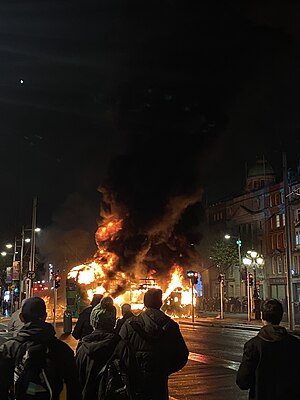Policing in Dublin is in crisis. It took an orgy of destructive rioting and looting to bring a significant visible Garda presence back to the streets. But for years, a general sense of disorder, low grade criminality, violence and hooligan impunity has been developing. Social media showed desperate shopkeepers and their staff fending off opportunistic raiders bent on theft and vandalising stocks.
City councillors gave Commissioner Harris a very clear picture of what is happening on Monday; it saddens me to see current proposals to abolish local government joint policing committees.
Those involved in the orgy of destruction were criminal thugs – bicycle thieves, shoplifters, vandals, drug pushers and couriers, muggers, burglars, phone snatchers, knife-carriers, shop-raiders, and head stompers. They are being fed an on-line diet of racist and xenophobic lies.
Some of the same loudmouth elements which once used drugs as an excuse for community intimidation have now latched on to immigration as a pretext for asserting dominance in deprived communities. To call them “right wing” may be convenient as a tag for being anti-immigrant, but I am by no means convinced that if any of them vote, that they would not vote for left-wing candidates.
The sight of a Garda sergeant being severely assaulted by a group of masked, hooded thugs was disgusting and frightening for many people. That footage demonstrates that the Gardai must re-establish their authority by a credible physical presence in the city centre backed, whenever necessary, by an available public order unit. I remember when Dublin Gardai on the beat carried a hefty baton case on their belts. Nobody messed with them.
In 2002 the incoming government of which I was a member had a manifesto commitment to increase the numbers of Gardai from 12,000 to 14,000. Until mid-2004 the Department of Finance resisted implementation of that commitment. I recall one civil servant warning me that deploying extra Gardai in those numbers would result in an increase of reported crime! The main opposition spokesman had claimed that it would take 20 years to increase the force by 2000. By 2007, the additional 2000 Gardai had been recruited.
The sad fact is that 15 years later, the number of Gardai in Ireland is approximately 13,900. In that time the Irish population has grown from 4.3 million to 5.05 million, an increase of 17%. But the number of Gardai has remained static. The Garda Reserve rose to 1100 but has slumped to about 400, of which just over 100 are in the Dublin metropolitan region. The government committed to increasing the force strength to 15,000 and the Reserve to 2000 and the civilian support staff to 4000.
Functions of Gardai have become more complex and bureaucratic. Visible street-policing has given way to other roles and duties. Morale is low. Governance structures of policing have been experimented with little success. There is a lot to be said for reinstating the simpler structures in the 2005 and 2007 legislation which affirmed the roles of Minister, Commissioner and a small board of management.
Dubliners know that visible policing of their city has withered. That must change. The image of the city has been severely damaged by the rioting, burning, and looting. But it is not just a question of image; the daily reality of under-resourcing the police function is really damaging, not least to the most vulnerable and deprived.
Even allowing for the unforeseen effects of the Covid lockdowns, the image of Fine Gael in particular as a party of law and order has been very badly damaged.
The entire system of criminal justice is in crisis. Our prison capacity has reached the point that prisoners are being accommodated in grossly overcrowded conditions with mattresses on the floors. Massive delays in the trials of serious offences have masked the underlying prison crisis to an extent. We are approaching a renewal of the revolving prison door. Trials have been permitted to become incredibly lengthy.
The case for building the stalled Thornton Hall project has never been stronger, as the Department of Justice well knows. The Victorian Mountjoy prison complex can never become an appropriate penal facility for the 21st century. Its very valuable 20-acre site in the city centre should be sold for urban renewal and home building development.
The new campus of 150 acres planned for Thornton Hall can accommodate modern penal facilities, and a range of units from high security, lower security, psychiatric and detox units, and education, training, and rehabilitation units, while eliminating overcrowding and the breeding ground for violence and intimidation. We need this to be done.
Our government is afflicted by a sense of lassitude about security. When the strength of the Defence Forces and the reserve is melting away and the Naval Service is largely tied up for want of ratings, they are talking about ending the triple-lock. We’ve got to get real.

